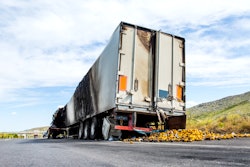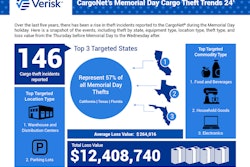Cargo theft is a serious issue in the industry and the problem is only getting worse. According to CargoNet’s Annual Supply Chain Theft Incident Analysis, more than 2,900 incidents of cargo theft were reported last year, up more than 57% compared to 2022.
Theft can happen anywhere, anytime if you aren’t careful, so it’s important to understand what your company can do to reduce your chances of becoming a cargo theft victim. Here’s how you can help drivers avoid situations that could put themselves and the cargo they’re hauling at risk.
At the terminal
Your facility already has a lot of safeguards, but there are a couple of things to watch out for as you are moving around the terminal. Drivers should keep an eye out for outsiders trying to gain access to cargo areas but also watch for internal threats—people who actually work there but are not authorized to be in sensitive sections of the building. Drivers should verify that secure areas stay locked (with proper training on the security procedures for keys), and they should also feel empowered to escort unidentified visitors to reception and report any damaged or non-functioning security elements like locks, fences, or lights.
Before the trip
Part of a pre-trip inspection should include looking out for obvious tampering, either with the cargo -- the security seal -- or with the vehicle itself. Remind drivers to check that the shipping papers match what was loaded onto the vehicle and that all packaging is marked and labeled properly. It’s also a good idea to check for new screws or bolts, fresh paint or fiberglass patchwork, or other signs that part of the vehicle or trailer may have been altered. These are sometimes indications that someone is trying to hide contraband. It’s also worth researching from time to time to be informed of cities and regions where cargo thefts are more rampant to avoid stopping in these areas if possible. California, Texas, and Florida are states frequently cited as being among the top for cargo theft incidents.
On the road
Without the added protection of the terminal, cargo is more vulnerable on the road, but there are steps drivers can take to lower the risk there, too. Minimizing the number of stops will reduce the chances that thieves and hijackers will make a move (you may even have a no-stop policy for some high-value loads). Stopping to help stranded motorists might feel like the right thing to do, but drivers should be aware that things aren’t always what they seem. They should alert the authorities when they see someone in need of assistance, and you should make sure that your drivers understand the carrier’s policies about stopping to help. Encourage them to communicate with their supervisor regularly throughout a trip about significant delays, traffic, and re-routing.
During a stop
When taking a break, cargo can be kept safer by parking the truck in a designated truck parking area with good lighting and where drivers can keep an eye on the vehicle. Give your drivers a list of facilities with video surveillance for added security. If possible, they should park a loaded trailer against a wall, fence, or other fixed object to enhance the safety of their cargo. Before leaving the truck, have drivers take a moment to survey the area and familiarize themselves with the surroundings. And of course, they should follow standard safety procedures, such as keeping keys with them, turning off the engine, locking the doors, and only unlocking the truck for a minimal amount of time when necessary.
The delivery
When arriving at the customer’s location, it may seem like the risks are lower (they’re back in a secured facility, after all). But there are still some things to watch out for. Drivers should take a moment to assess the safety of the loading docks or warehouse before unloading—avoid unloading in poorly lit areas or on public sidewalks. When meeting the actual receiver, they should always ask for identification (and be on the lookout for any suspicious individuals hanging around during unloading). Even more important, underscore the importance of telling the dispatcher about any last-minute changes to the delivery destination or friendly requests to move some trailers around ‘as a favor.’
The driver is just one part of a whole team of dispatchers, managers, and other honest players who want shipments to go safely and smoothly. However, for that team to function well, each person needs to work together to support the well-being of drivers and cargo on the roads. Getting your drivers to follow these tips and the best practices described in your policies and procedures will go a long way toward ensuring the safety of your cargo and your people.













